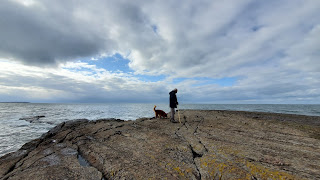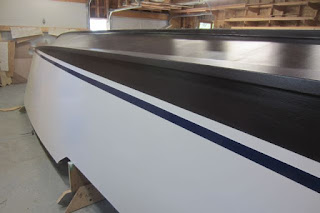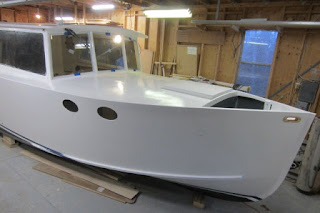
Welcome. This blog is intended to share and discuss upgrades and modifications to Windstar, my 1985 C&C 33 mk ii. please use the web view and browse the posts by type or date.
Sunday 31 January 2021
Dad's next boat

Saturday 30 January 2021
New Sheaves?
The bronze bushings in these sheaves were worn when I acquired Windstar and I was able to re-bush them fairly easily, They are in good shape and spin freely with little play. I grease and inspect them annually
They have two grooves indicating that they were originally intended for wire-to-rope halyards, and as you can see, the wire groove is very shallow.
It is often stated that when transitioning to all-rope halyards, that sheaves must be replaced with an appropriate type, presumably without any wire groove.
My now all-rope main halyard is wearing somewhat after 4 seasons or so and I should probably replace it..
The main halyard is the largest of the 5 lines that pass over the masthead sheaves, and is as large an OD as the sheave can accommodate. It is also the most often used. When Windstar is docked, the halyard is attached to the end of the boom. It will be more active than the others even in repose, so may be more subject to chafe.
Is the halyard wear I'm seeing a result of this shallow groove in the sheave, the diameter of the halyard, or is it simply normal wear?
If I should replace the sheave, can anyone suggest a source and type?
Wednesday 27 January 2021
seasonal maintenance
Page under construction.
Every year:
drain raw water strainer, muffler, water heater, and fresh water system
Oil and filter. Trans oil every 2 seasons
Disconnect hose to raw water cooling pump and drain. blow through the hose to ensure it’s clear. In spring you will insepct the impeller
While pumping out holding tank before haul out, use pressure water system to fill toilet bowl with fresh water- leave hand pump valve open so that vaccum can suck the water from the bowl, rinsing the hose and ultimately leaving it the pump assembly and the bowl empty.. No need for antifreeze if this is empty. I leave the deck fitting open over the winter.
Pump antifreeze through shower pan, fridge drain, water tank through pressure system via head and galley, plus galley foot pump
Replace the joker valve in head, lubricate the heck out of every thing else. If you don't do the joker valve, you will find black water back filling into the head in certain conditions.
clean filter screens in shower pan pump (under foreward end of port settee, and below galley sink
Spring
blast furler head swivel bearings clean and lubricate. This can cause enough friction under load to cause a halyard wrap. Dangerous.
Lubricate whisker pole
Inspect belts
When mast is down,
clean, grease and inspect the masthead sheaves and axles and bushings.. This is so easy it makes no sense not to do it, and you can inspect the halyards at the same time.
Since you are at the mast.... see below - really good advice from Chuck S in Maryland. Simple stuff that together makes for a big improvement in reliability and enjoyment.
Earlier I reported that I raise the mainsail on my 36 ft saiboat by hand. Well I couldn't do that when I first got my boat and needed to use a winch on halyards. My sailing friends told me that was normal and winches were always necessary to hoist such large sails. My mainsail weighs only 55 to 60 pounds, so I thought they might be wrong. Later, I spent some time checking all of the mast base halyard blocks and freeing a few frozen sheaves in the deck organizer, I found I could raise the mainsail by hand very easily. These sheaves are deceptive when frozen and allow a halyard to pass unimpeded initially when there is no load, but once the strain comes on, if they are frozen, the halyard becomes bar taught and the job requires a winch. I also learned from reading the winch catalog that the largest loads; the genoa and main halyards work best if reeved along the most direct path to the right side of a winch drum. So now I pick the clutch directly in line with the right side of the Starboard winch drum for my main halyard. All my winch drums turn clockwise. My genoa halyard is reeved through the clutch directly in line with the right side of the Port winch drum. I run the spinnaker halyards through the outermost clutches and all the other lines have lower loads so can be run as you like. And I label the clutches.
Monday 25 January 2021
Less awful Mast Climbing
Pretty cool video showing how the various pieces of climbing gear can be used.
https://www.youtube.com/watch?v=uFagzKDp2c0
https://www.youtube.com/watch?v=WcUmdGIf21o
A counterpoint to that, an explanation of prussik knots and their use as ascenders. DIY!
https://www.vdiffclimbing.com/prusik-types/
Summary- it appears that the heart of this
- 2 ascenders (one for harness, one for foot/feet)
- 1 foot loop/aider or similar. This could probably be optimized for boat use as weight and bulk is less of an issue than for climbing gear. (Hence the atn mastclimber)
- 1 climbing harness or bosun's chair
- 1 means to haul up tethered tools etc (storage bag double as tool bag, clip to chair/harness)
Other -
- means to secure to mast,
- third ascender to secure to second line as a safety
- helmet
- Locking Carabiners as required
Update
Many recommend the ATN mastclimber.
The sailrite folks do a very good job of explaining things.
https://www.youtube.com/watch?v=Ij-_ZEPsI6Y
Here's a link Bob sent on the subject as well.
https://l-36.com/UltimateMastClimbing.php
and another article.
https://www.oceannavigator.com/mast-climbing-techniques/
Good explanation here -
How to climb a mast solo at sea - Yachting Monthly - YouTube
Original Post:
I've been up the mast a few times and didn't enjoy it much. I'm not abnormally fearful, just that the method was ad hoc and cumbersome. In a recent discussion online Marek piqued my curiosity after a brief discussion of HIS method, employing climbing gear. I asked for and he provided a great deal of information. See below. Thanks Marek!
Dave,
I use climbing ascenders. Something like this: https://www.mec.ca/en/product/
You also need a harness (e.g., https://www.mec.ca/en/product/
You need one ascender for your harness, and another for your leg loop. A simple webbing loop would do. A climbing one might have an advantage of being more pliable. If you want to be really efficient, you may want to tie the leg loop to your foot. A simple knot dividing the loop into a footstep and the rest is sufficient. The idea is that the foot should stay in the loop, even if the loop is not tensioned. You will have to experiment with the optimal length of the foot loop.
This works in a similar way to the mast climbing gear from ATN. A good review of similar aids is here: https://www.sailmagazine.com/
If you have the above and you also have someone to help you:
- Put your harness on
- Cleat the halyard 1 (e.g. main) fast; make sure that it is tensioned as much as you can.
- Put the two ascenders on the halyard
- Attach the harness to the upper ascender; attach the foot loop to the lower one
- Move the harness ascender up, as far as you can reach
- Move the foot ascender up
- Lift yourself on the foot
- Move your harness ascender up
- Continue…
This way you would be moving along the tightened halyard in a caterpillar fashion.
To help to stabilise yourself to the mast, have an extra loop that runs around the mast. This will prevent swinging around the mast (and even more so, away from the mast). You will need to detach it when moving around the spreaders.
The extra person uses the second halyard (jib?) to keep you from falling (if anything fails). She does not need to winch you up; rather, she only needs to keep that line taut.
For working at the very top, I use a couple of aiders: (e.g., https://www.mec.ca/en/product/
If you have to do it solo (and I often do), you need a third ascender. The idea is that instead of having your partner belaying you on the second halyard, you use the 3rd ascender on the second halyard. This is your safety.
NB. Never use shackles for connecting to the halyard – always use knots. Never use spinnaker halyard (hanging off the mast crane); use only halyards that go through the mast (eliminates any dangers of failing blocks). Always inspect both halyards before you use them. Never trust your life to a single rope. All carabiners that you will use for this exercise have to be the safety type (with a lock).
The aiders mentioned above are also useful when climbing the mast. Instead of the foot loop, use one of those and climb a few steps, then move your harness ascender up, and then move the aider up.
It gets easier with practice.
A couple of words of caution, if you are planning to use climbing gear to ascend the mast:
- many ascenders have little teeth to provide the grip. These teeth can damage the rope. I would not use them on my halyards. If you want to use those, replace the halyard with a different rope that you would use only for climbing the mast.
- if you are planning to abseil from the top of the mast using any of the climbing devices, again, don’t use the halyard. Abseiling a few times down the line will make the line very stiff. Not to mention that climbing ropes are usually much softer than what we use for halyards, so using a climbing rope would work much better.
Marek
Good luck
Marek
Sunday 24 January 2021
Bimini mods for Solar Panel
Fools rush in where angels fear to thread.
The approach to panel mounting was inspired by the approach taken at the link below (Great site!)
https://marinehowto.com/installing-a-solbian-semi-flexible-solar-panel/
I purchased some materials.
https://www.jtsoutdoorfabrics.com/
I checked out a few useful videos from Sailrite on youtube:
https://www.youtube.com/c/SailriteDIY/videos
For background, Here's the prior post on this solar project.
https://cncwindstar.blogspot.com/2020/09/4-chargers-controllers-and-monitoring.html
Finally after procrastinating awhile I overcame my fear of the unknown and tackled the project.
Industrial Velcro (from Amazon) - strong stuff!
For the rest, he photos tell the story:
Almost done. Still required is the velcro on the top perimeter of the solar panel that will hold the folded lapels in place, and a bit of tweaking to permit the cables to be routed down the exterior of the bimini frame. Am now imagining a pile of clever canvas projects, and am contemplating the addition of another panel on my dodger.
Tuesday 19 January 2021
Sail inventory
See below for Windstar's existing sail inventory. Not sure how to measure the full radial spinnaker, other than knowing it is bigger than the asymmetrical. I also have a spinnaker staysail I've never tried, that might be the right size....
Just ordered a new #2 (114%) tri-radial furling Genoa from Rolly Tasker in Thailand - this should work well for local conditions. The #1 (140%) is quite large, often too large, and the working jib (93%) doesn't get us to hull speed in light air. Can't wait to try the new one out!
The main is a custom "racing" sail by Evolution in Toronto - 2 full battens, crosscut with radial corners, and cut to full PHRF size to maximize area at the cost of occasionally having the batten foul the backstay.
Watching the finale of the 2020 Vendee Globe and I cant help but muse about a bowsprit and a furling chute!




































